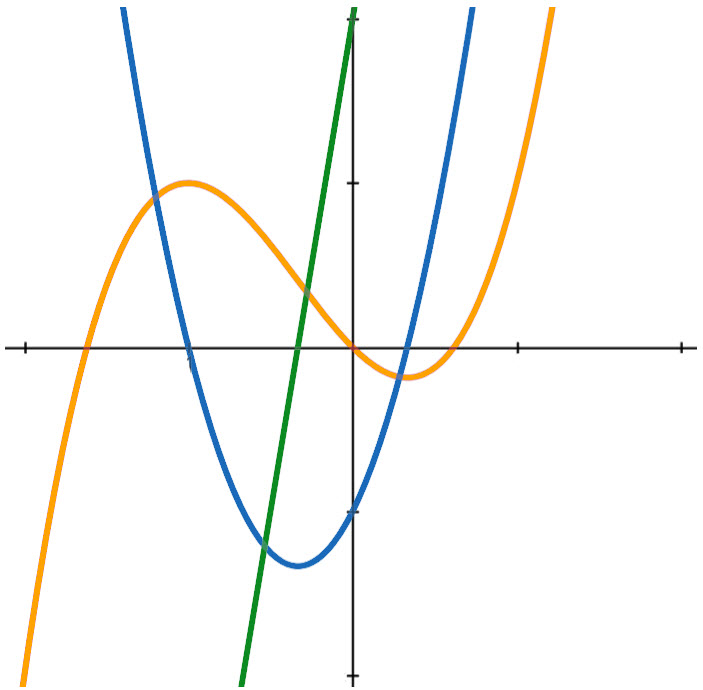Andymath.com features free videos, notes, and practice problems with answers! Printable pages make math easy. Are you ready to be a mathmagician?
Notes

Problems
Find the derivative of the function.
\(\textbf{1)}\) \(f(x)=-3 \cos x\)
\(\textbf{2)}\) \(f(x)=\pi-\cos x\)
\(\textbf{3)}\) \(f(x) = \pi \sin x + 2\pi x\)
\(\textbf{4)}\) \(f(x)=-4 \sin x+4 \cos x\)
\(\textbf{5)}\) \(f(x)=5x^{3} \cos x\)
\(\textbf{6)}\) \(f(x) = 4 x^2 \sin (x) \)
\(\textbf{7)}\) \(f(x) = \cos (x) \sin (x)\)
\(\textbf{8)}\) \(f(x) = \sin(3x^2)\)
\(\textbf{9)}\) \(f(x) = \displaystyle \frac{\sin x}{x^2}\)
\(\textbf{10)}\) \(f(x) = x^3 \sin(x^2)\)
\(\textbf{11)}\) \(f(x) = \sin^2 x\)
\(\textbf{12)}\) \(f(x) = x^2 \cos(2x)\)
\(\textbf{13)}\) \(f(x) = \displaystyle \frac{\cos x}{x}\)
\(\textbf{14)}\) \(f(x) = x \sin(5x)\)
\(\textbf{15)}\) \(f(x) = \displaystyle \frac{x^3}{\sin x}\)
See Related Pages\(\)
\(\bullet\text{Trig Derivative Calculator }\)
\(\,\,\,\,\,\,\,\,\text{(Symbolab.com)}\)
\(\bullet\text{ Calculus Homepage}\)
\(\,\,\,\,\,\,\,\,\text{All the Best Topics…}\)
\(\bullet\text{ Definition of Derivative}\)
\(\,\,\,\,\,\,\,\, \displaystyle \lim_{\Delta x\to 0} \frac{f(x+ \Delta x)-f(x)}{\Delta x} \)
\(\bullet\text{ Equation of the Tangent Line}\)
\(\,\,\,\,\,\,\,\,f(x)=x^3+3x^2−x \text{ at the point } (2,18)\)
\(\bullet\text{ Derivatives- Constant Rule}\)
\(\,\,\,\,\,\,\,\,\displaystyle\frac{d}{dx}(c)=0\)
\(\bullet\text{ Derivatives- Power Rule}\)
\(\,\,\,\,\,\,\,\,\displaystyle\frac{d}{dx}(x^n)=nx^{n-1}\)
\(\bullet\text{ Derivatives- Constant Multiple Rule}\)
\(\,\,\,\,\,\,\,\,\displaystyle\frac{d}{dx}(cf(x))=cf'(x)\)
\(\bullet\text{ Derivatives- Sum and Difference Rules}\)
\(\,\,\,\,\,\,\,\,\displaystyle\frac{d}{dx}[f(x) \pm g(x)]=f'(x) \pm g'(x)\)
\(\bullet\text{ Derivatives- Sin and Cos}\)
\(\,\,\,\,\,\,\,\,\displaystyle\frac{d}{dx}sin(x)=cos(x)\)
\(\bullet\text{ Derivatives- Product Rule}\)
\(\,\,\,\,\,\,\,\,\displaystyle\frac{d}{dx}[f(x) \cdot g(x)]=f(x) \cdot g'(x)+f'(x) \cdot g(x)\)
\(\bullet\text{ Derivatives- Quotient Rule}\)
\(\,\,\,\,\,\,\,\,\displaystyle\frac{d}{dx}\left[\displaystyle\frac{f(x)}{g(x)}\right]=\displaystyle\frac{g(x) \cdot f'(x)-f(x) \cdot g'(x)}{[g(x)]^2}\)
\(\bullet\text{ Derivatives- Chain Rule}\)
\(\,\,\,\,\,\,\,\,\displaystyle\frac{d}{dx}[f(g(x))]= f'(g(x)) \cdot g'(x)\)
\(\bullet\text{ Derivatives- ln(x)}\)
\(\,\,\,\,\,\,\,\,\displaystyle\frac{d}{dx}[ln(x)]= \displaystyle \frac{1}{x}\)
\(\bullet\text{ Implicit Differentiation}\)
\(\,\,\,\,\,\,\,\,\)
\(\bullet\text{ Horizontal Tangent Line}\)
\(\,\,\,\,\,\,\,\,\)
\(\bullet\text{ Mean Value Theorem}\)
\(\,\,\,\,\,\,\,\,\)
\(\bullet\text{ Related Rates}\)
\(\,\,\,\,\,\,\,\,\)
\(\bullet\text{ Increasing and Decreasing Intervals}\)
\(\,\,\,\,\,\,\,\,\)
\(\bullet\text{ Intervals of concave up and down}\)
\(\,\,\,\,\,\,\,\,\)
\(\bullet\text{ Inflection Points}\)
\(\,\,\,\,\,\,\,\,\)
\(\bullet\text{ Graph of f(x), f'(x) and f”(x)}\)
\(\,\,\,\,\,\,\,\,\)
\(\bullet\text{ Newton’s Method}\)
\(\,\,\,\,\,\,\,\,x_{n+1}=x_n – \displaystyle \frac{f(x_n)}{f'(x_n)}\)
In Summary
Trigonometric Derivatives are typically covered in Calculus I. Trig Derivatives are mathematical concepts that involve calculating the rate of change of a trig function. These concepts are often studied in calculus, a branch of mathematics that deals with the study of rates of change and the accumulation of quantities. Understanding trig derivatives is important because they are used in many different fields, including physics, engineering, and economics. For example, they can be used to model the motion of objects, analyze electrical circuits, and predict financial trends.
Here’s a fun fact about derivatives of sin and cos: The derivative of sin x is equal to cos x, and the derivative of cos x is equal to -sin x.
Math Topics that use trig derivatives
Taylor series: The derivatives of sin and cos are used in the development of the Taylor series, which is a representation of a function as an infinite series of terms that can be used to approximate the function.
Laplace transforms: The Laplace transform is a mathematical tool used to solve differential equations, and it involves the derivatives of sin and cos.
Fourier series: The Fourier series is a representation of a periodic function as a sum of sines and cosines, and the derivatives of these functions play a role in the development of the series.
About Andymath.com
Andymath.com is a free math website with the mission of helping students, teachers and tutors find helpful notes, useful sample problems with answers including step by step solutions, and other related materials to supplement classroom learning. If you have any requests for additional content, please contact Andy at tutoring@andymath.com. He will promptly add the content.
Topics cover Elementary Math, Middle School, Algebra, Geometry, Algebra 2/Pre-calculus/Trig, Calculus and Probability/Statistics. In the future, I hope to add Physics and Linear Algebra content.
Visit me on Youtube, Tiktok, Instagram and Facebook. Andymath content has a unique approach to presenting mathematics. The clear explanations, strong visuals mixed with dry humor regularly get millions of views. We are open to collaborations of all types, please contact Andy at tutoring@andymath.com for all enquiries. To offer financial support, visit my Patreon page. Let’s help students understand the math way of thinking!
Thank you for visiting. How exciting!